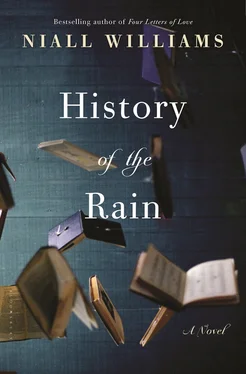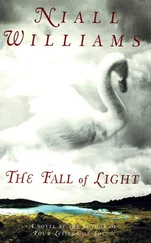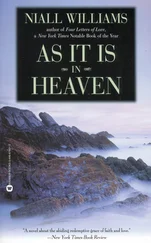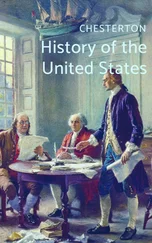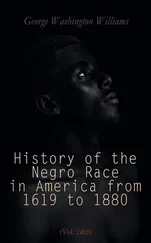We tell stories. We tell stories to pass the time, to leave the world for a while, or go more deeply into it. We tell stories to heal the pain of living.
When Mary MacCarroll sees Virgil Swain on Fisher’s Step she doesn’t fall in Love right away. She falls in Curiosity, which is less deep but more common. She sees a man with a sunburned face and ragged beard and presumes he’s a fisher. She has come out of the house to clear her head and walked in the April rain without purpose or destination. Often she walked the riverbank. The Shannon is a masculine river. It’s burly and brown and swollen with rain. It shoulders its way out between Kerry and Clare with an indifferent force but when you walk alongside it down where the fields fall away and the line of the land is this frayed green edge you can get a kind of river peace. I used to love walking there. Running water is best for daydreams, Charles Dickens said, and he was right.
Mary sees the man and knows he’s a stranger. He is standing looking at the river the way only fishermen do. But she sees no rod or tackle, and as she approaches she has enough sense of her own beauty to expect him to turn to look at her.
He doesn’t.
She walks three feet behind him, and he doesn’t turn. She goes on down the bank, discovers a seed of curiosity is cracking in her, and opening now, unfurling a first feathered edge as she thinks he’s looking now and makes as though tossing her hair but is checking to see if his head has turned.
It hasn’t.
She is only eighteen but has already taken enough possession of the world to know her own impact in it. It isn’t vanity like Anna Prender in Kilmurry who’d be happy if you carried a full-length mirror alongside her or Rosemary Carr inside in Kilrush who Nan says is in love with her own backside, it’s a natural thing. It’s what happens in small places. It’s what happens when your father was Spencer Tracy and you come to Mass walking with your head MacCarroll high and have a kind of ease and grace that people notice. It’s what happens when the timbers of the Men’s Aisle groan under the forward strain as you come up to Communion, or the biggest male attendance in Faha church occurs the evening of the Feast of Saint Blaise when Father Tipp is going to bless your arched bare throat. Something like it is in a poem of Austin Clarke’s in Soundings which Mrs Quinty used to teach us in TY. The ‘Sunday in every week’ one.
She’s used to it, that’s all.
And he doesn’t turn.
Well that’s fine. She doesn’t really care. She walks on down the river to the end of Ryan’s and she crosses out over the place where the wire ends. She goes along by O’Brien’s and up to Enright’s, all the time the rain falling softly and all the time the seed feathering some more.
Who is he?
She stops to talk with one of the Macs who are out counting cattle and says there is a stranger back along the way, but she only gets a that right? in reply and that doesn’t satisfy the thing the Curiosity craves. It wants to talk about him. It doesn’t matter what is said as long as something is, as long as somehow the mystery of him gets out of the place inside where the feathering is madding now.
She goes back along the bank, back past O’Brien’s and Enright’s and over the wire into Shaughnessy.
There he is, in the very same place. He hasn’t moved.
This time she can look at him as she approaches. She can allow the Curiosity what it needs, it needs detail; the way in profile his hair looks roughly barbered, the way the beard runs down into his shirt collar, the way the sun and sea have early-aged him. Details: boots without laces, she has never seen boots like them, trousers foreshortened by long wear and knee-gathers, the shirt that had once been white, the jacket he wears, tan leather, square-cut, thousand-creased, both dark-polished and dulled by weather, the jacket which later she will learn he got in Quito in Ecuador and from which he cannot be separated. There’s a paperback book that’s too tall for the jacket pocket. (It’s the Collier Books edition of W.B. Yeats’s Mythologies , Book 1,002, published in New York, priced $4.95, and on the cover the poet is young and melancholic, forelock falling on to his left eyebrow. It’s the book that brought Virgil back to Ireland, the one that begins with ‘A Teller of Tales’ where WB says the stories in it were told to him by Paddy Flynn in a leaky one-roomed cabin in the village of Ballisodare. It’s the one where he says In Ireland this world and the world we go to after death are not far apart . The tops of pages are river-and-rain-warped, the whole book buckled a bit from travel, age and pockets, but it’s a book that feels companionable somehow, if you know what I mean. In it there are many pages with lines underscored, or in some cases with just ascending wing-like Nike tick-marks next to a paragraph. Sometimes the marks have been made in different inks and therefore different times, so that in ‘Drumcliff and Rosses’ after Yeats tells of Ben Bulben and Saint Columba there’s a wavy black line under how he climbed one day to get near Heaven with his prayers , but in ‘Earth, Fire and Water’ there are two red strokes slashed down in the margin next to I am certain that the water, the water of the seas and of lakes and of mist and rain, has all but made the Irish after its image . Between pages 64 and 65, ‘Miraculous Creatures’, there’s one of those old grey cinema tickets on which is printed Admit One.)
Mary hasn’t seen a man so still, she hasn’t seen a man with a jacket like that, with a book in his pocket.
She walks back towards him. He’ll say hello this time, she thinks. He’ll know it’s me. Somehow he’ll have seen me the first time without my knowing and this time he’ll turn and say hello.
Maybe he’ll just turn and nod, she thinks. But at least then she will see his face.
She goes along the track by the river, it’s muck-tacky with rain, heels of her boots sucking. She is ten yards from him, then five; then she is passing behind him. He hasn’t turned.
What is the matter with him?
If she reaches she could put her hand on his back. If she reaches she could shove him into the river, and for a flash moment she is the girl who will do it, who will suddenly stop and push her two hands into the small of his back and send him spinning into the Shannon.
What is the matter with him? Is he deaf or blind or just rude?
She goes ten yards past when she decides to turn and tell him that this is Matty Shaughnessy’s field and it’s private. Fifteen when she thinks no she won’t. Twenty when she thinks she will fall over, go the full Jane Austen, hurt her ankle and cry out, twenty-five when she’s too mad and won’t give him the satisfaction and thirty when she comes through the stile out of the field and looks back to see him still standing there.
‘There’s a stranger down at the river,’ she tells her mother. And that is a first relief. It’s relief just to say stranger because then he is already somebody, and she is already connected to him.
That’s how I see it anyway. That’s how I see it when I ask Mam ‘How did you first meet Dad?’ and each time she tells me the story of Not Meeting, of Passing by, and how it seems to me God was giving them every chance not to meet, and the singular nature of their characters will mean their stories will run parallel and never do a Flannery O’Connor. Never converge.
‘Is there?’ Nan says. She’s flour-elbows in this scene. It’s a bit Walter Macken meets John B. Keane because she’s breadmaking the loaves she sells in Nolan’s shop to keep them alive. Her dancing days are over and Spencer Tracy is on black-and-white reruns in her head now, but she knows this day is coming. You can’t have a daughter that beautiful and not know.
Читать дальше
